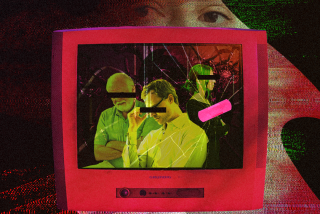The Power of TV Images
- Share via
Asian and Latino children, even as their numbers in the population grow, rarely see themselves on television. At an impressionable age, when they are forming positive or negative self-images, they are often left out of the picture altogether. When they are included, they may be portrayed as nonessential or stereotypical. White children nearly always see themselves, and black children increasingly see people who look like them, though often in unflattering portrayals. These are the findings of “A Different World: Children’s Perceptions of Race and Class and Media,” a study conducted on behalf of Children Now, the Oakland-based advocacy group.
These results should challenge broadcast executives to play fair on the air. Though why should they, when basically all-white shows like “Seinfeld” and “Friends” top the ratings? The answer is in demographics. Entertainment executives who know anything about U.S. population estimates realize that before too long, Latinos will constitute 25% of the national market; Asians remain the fastest-growing minority. They are viewers of the future, the customers sponsors will covet.
All children are sensitive to what they watch on television, whether the programming is news or entertainment. They draw conclusions. They believe, said the study, that white characters are more likely to be rich, smart and successful. They are leaders, doctors, police officers--never maids or janitors. Minority characters are more likely to be poor, lazy, criminal or goofy. Asian characters are often unnoticed. These early impressions matter. Children quickly pick up stereotypes and inequities; they all recognize the real role models.
In his 1947 landmark study, Kenneth Clark, a psychologist at the City University of New York, and his wife Mamie asked black and white children ages 3 to 7 to choose among four dolls, two black and two white. Though the test subjects were split 50-50, two-thirds of the children preferred white dolls. The Clarks concluded from their study of doll preferences that segregation--which at that time included a complete absence of positive black images in the mass media--produced harmful psychological effects in black children. The U.S. Supreme Court cited this influential research in its 1954 Brown vs. Board of Education desegregation decision. Even when the same test was repeated 10 years ago, the results were the same.
Today, if put to a similar test, which doll would Latino and Asian children choose? Broadcasters ought to worry about the answer.
(BEGIN TEXT OF INFOBOX / INFOGRAPHIC)
Children of differing races and ethnicities were asked:
How often do you see your race on television?
*
White:
Very often: 71%
Often: 19%
Every now and then: 9%
Never: 0%
*
African-American
Very often: 42%
Often: 36%
Every now and then: 18%
Never: 3%
*
Latino
Very often: 22%
Often: 27%
Every now and then: 44%
Never: 7%
*
Asian
Very often: 16%
Often: 20%
Every now and then: 51%
Never: 13%
Source: Children Now
More to Read
The complete guide to home viewing
Get Screen Gab for everything about the TV shows and streaming movies everyone’s talking about.
You may occasionally receive promotional content from the Los Angeles Times.






